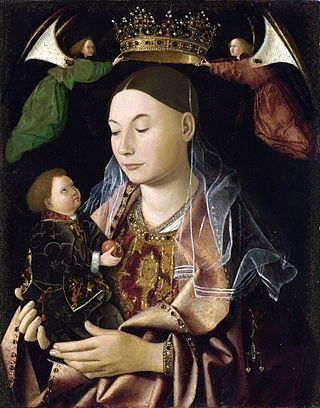
Quentin Matsys (1466–1530) was a Flemish painter in the Early Netherlandish tradition. He was born in Leuven. There is a tradition alleging that he was trained as an ironsmith before becoming a painter. Matsys was active in Antwerp for over 20 years, creating numerous works with religious roots and satirical tendencies. He is regarded as the founder of the Antwerp school of painting, which became the leading school of painting in Flanders in the 16th century. He introduced new techniques and motifs as well as moralising subjects without completely breaking with tradition.

Antonello da Messina, properly Antonello di Giovanni di Antonio, but also called Antonello degli Antoni and Anglicized as Anthony of Messina, was an Italian painter from Messina, active during the Italian Early Renaissance.

Polidoro Caldara, usually known as Polidoro da Caravaggio, was an Italian painter of the Mannerist period, "arguably the most gifted and certainly the least conventional of Raphael's pupils", who was best known for his now-vanished paintings on the facades of Roman houses. He was unrelated to the later painter Michelangelo Merisi da Caravaggio, usually known just as Caravaggio, but both came from the town of Caravaggio.

Colantonio was an Italian painter, who was the outstanding native figure in the art of Naples in the Early Renaissance.
Andrea Solari (1460–1524) was an Italian Renaissance painter of the Milanese school. He was initially named Andre del Gobbo, but more confusingly as Andrea del Bartolo a name shared with two other Italian painters, the 14th-century Siennese Andrea di Bartolo, and the 15th-century Florentine Andrea di Bartolo.

Petrus Christus was an Early Netherlandish painter active in Bruges from 1444, where, along with Hans Memling, he became the leading painter after the death of Jan van Eyck. He was influenced by van Eyck and Rogier van der Weyden and is noted for his innovations with linear perspective and a meticulous technique which seems derived from miniatures and manuscript illumination. Today, some 30 works are confidently attributed to him. The best known include the Portrait of a Carthusian (1446) and Portrait of a Young Girl ; both are highly innovative in the presentation of the figure against detailed, rather than flat, backgrounds.

Justus van Gent or Joos van Wassenhove was an Early Netherlandish painter, perhaps from Ghent, who after training and working in Flanders later moved to Italy where he worked for Federico da Montefeltro, duke of Urbino, and was known as Giusto da Guanto, or in modern Italian Giusto di Gand etc. The artist is known for his religious compositions executed in the early Netherlandish idiom and a series of portraits of famous men, which show the influence of early Italian Renaissance painting.

Saint Sebastian is a painting, once part of a triptych by the Italian Renaissance artist Antonello da Messina, completed in 1477–1479. It is housed in the Gemäldegalerie Alte Meister, Dresden, Germany.

Saint Jerome in His Study is a painting by the Italian Renaissance master Antonello da Messina. The painting depicts human, natural, and divine knowledge, and is filled with architectural qualities. It was the property of Antonio Pasqualino and afterwards of Thomas Baring, 1st Earl of Northbrook; since 1894 it has been in the collection of the National Gallery, London.

Christ at the Column (Pillory) is a small painting by the Italian Renaissance artist Antonello da Messina, executed c. 1476–1478, showing the Flagellation of Christ. It is in the Louvre in Paris.
Portrait of a Man is the conventional title of several male portraits by the Italian Renaissance artist Antonello da Messina.

The Crucifixion is the subject of three different paintings by the Italian Renaissance master Antonello da Messina; the first one was completed around 1454/1455, the second and the third in 1475. They are housed in the Brukenthal National Museum ; the Royal Museum of Fine Arts Antwerp and in the National Gallery, respectively.

Italian Renaissance painting is the painting of the period beginning in the late 13th century and flourishing from the early 15th to late 16th centuries, occurring in the Italian Peninsula, which was at that time divided into many political states, some independent but others controlled by external powers. The painters of Renaissance Italy, although often attached to particular courts and with loyalties to particular towns, nonetheless wandered the length and breadth of Italy, often occupying a diplomatic status and disseminating artistic and philosophical ideas.
The decade of the 1470s in art involved some significant events.
The decade of the 1450s in art involved many significant events, especially in sculpture.

This article about the development of themes in Italian Renaissance painting is an extension to the article Italian Renaissance painting, for which it provides additional pictures with commentary. The works encompassed are from Giotto in the early 14th century to Michelangelo's Last Judgement of the 1530s.

The Madonna with Child is a painting attributed on basis of style to the early Italian Renaissance master Antonello da Messina, depicting the Madona holding the doll-like Child and wearing an ornate golden crown, held by angels over her head. It is housed in the National Gallery, London. The name Salting, which is also applied to a Madonna by Robert Campin, denotes George Salting, the collector who donated it to the gallery in 1910.
Events from the year 1525 in art.

Lamentation (Pietà) is an oil painting on panel of the common subject of the Lamentation of Christ that is now regarded as by an artist in the "circle" of the Early Netherlandish painter Petrus Christus, rather than by Christus himself. It was painted in c. 1444, and is now in the Louvre in Paris.

The San Gregorio Polyptych is a tempera-on-wood polyptych painting by the Italian Renaissance master Antonello da Messina, completed in 1473 and housed in the Regional Museum of Messina, Italy.















